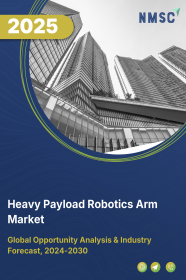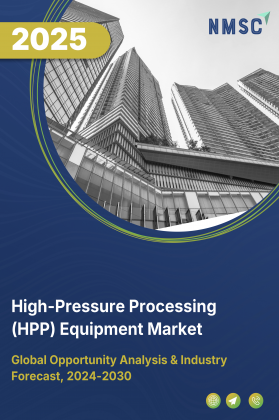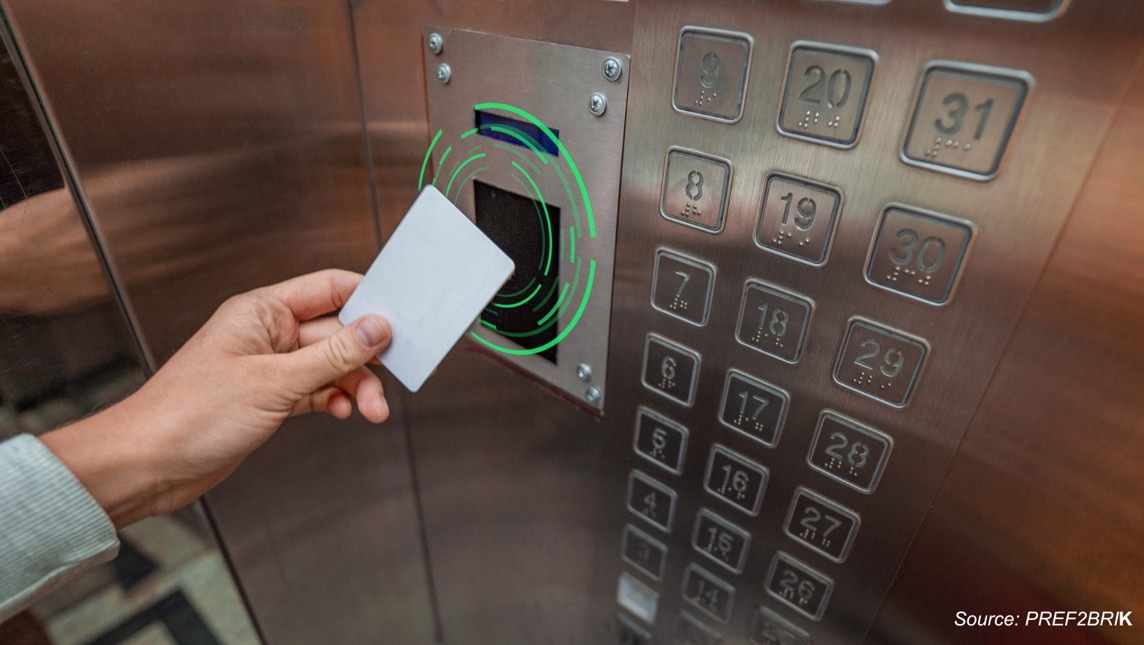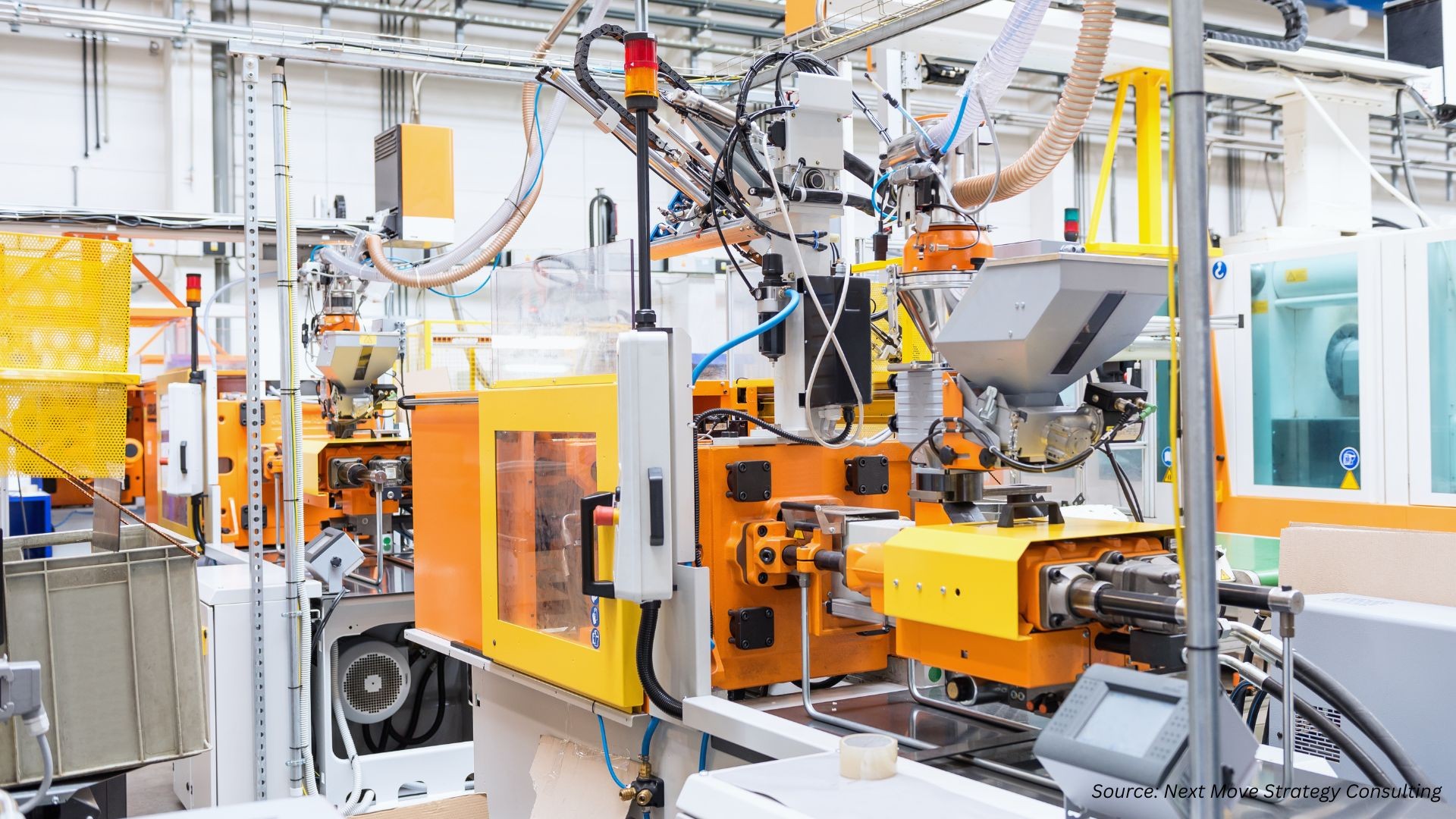
Heavy Payload Robotic Arm Market By Type (Articulated, Cartesian, SCARA, Cylindrical & Others), by Payload Capacity (500-700 Kg, 701-1,000 Kg, 1,001-3,000 Kg, and 3,001 Kg & above), By Application (Material Handling, Welding & Metal Fabrication, Palletizing & Packaging, and Others) and End-user Industry (Automotive, Healthcare, Electrical/Electronics, Metal & Machinery, Chemicals, Construction, and Others) - Global Opportunity Analysis and Industry Forecast, 2024-2030
Market Definition:
The Heavy Payload Robotic Arm Market size was valued at USD 12.69 billion in 2023 and is predicted to reach USD 17.67 billion by 2030 with a CAGR of 4.60% from 2024-2030.
Heavy payload robotic arm is a type of mechanical arm usually programmable with similar functions to a human arm. These arms are equipped with the end-effectors, sensors, actuators, and controllers. The heavy payload robotic arm helps to perform heavy duty tasks such as machine loading, palletizing, depalletizing, picking & placing, and parts transfer. Also, these mechanical arms deliver superior performance in tasks that are repetitive, labor intensive, physically enduring, and potentially dangerous for human labor.
Market Dynamics and Trends:
The increase in government spending on robotic systems as automation increases productivity of human along with rising use of robotic arms in packaging and handling of products in factories has fueled the demand for heavy payload robotic arms. For instance, in July 2020, China's State Council announced the "New Generation Artificial Intelligence Development Plan" to expand the domestic AI industry to USD 150 billion by 2030. In addition, the rising awareness regarding conservation of fossil fuel is letting to the adoption of robotic systems as robotic systems use less fuel and provides enhanced services is driving the market growth.
Moreover, the increased application of robotic arms in plastic and chemicals industries to increase productivity and precision by eliminating workers from difficult and hazardous tasks is further driving the market growth. However, high initial cost of manufacturing and maintenance of heavy payload robotic arm along with lack of skilled labor in manufacturing sector are the factors that are expected to restrain the growth of market during the forecast period. On the other hand, increase in the R&D activities related to the development of industrial robots are expected to create lucrative growth opportunities for the heavy payload robotic arm market players in the upcoming years.
Market Segmentations and Scope of the Study:
The heavy payload robotic arm market size has been segmented based on the basis of payload capacity, type, end-user industry, and geography. Based on payload capacity, the industry is classified into 500-700 Kg, 701-1,000 Kg, 1,001-3,000 Kg, and 3,001 Kg & above. Based on type, the market is bifurcated into articulated, cartesian, SCARA, cylindrical & others. Based on end-user industry, the market is classified into automotive, healthcare, electrical/electronics, metal & machinery, plastics & chemicals, machinery, mining, and others. The geography breakdown and analysis of each of the aforesaid segments includes regions comprising of North America, Europe, Asia-Pacific, and ROW.
Geographical Analysis:
Asia-Pacific region holds the lion share of heavy payload robotic arm market at present and is expected to boost the market growth during the forecast period. This is attributed to factors such as increased financial and regulatory support from governments to add robotic technologies in personal and professional applications in order to optimize operations and reduce labor-intensive operations.
For instance, in 2021, the Chinese government had announced ambitious plans for the country’s robotics industry. The government has listed the robotics industry, along with AI and automation, as one of the priority sectors for high-end development to push forward the transformation and upgradation of the manufacturing industry. Also, rising demand for service robots in the logistics industry due to the growing e-commerce sector to reduce the labor cost and optimize the processing speed is driving the market growth.
In addition, presence of several market players such as Kawasaki Heavy Industries Ltd, Kuka Robotics, Yaskawa and Nachi-Fujikoshi Corp that are continuously indulged in r&d activities related to robotics is further expected to drive the growth of the market in this region. For instance, in August 2021, Yaskawa launched HC10XP robot that facilitates collaborative welding for increased productivity. These robots were extremely fast and robust, that were added to Yaskawa Motoman’s MPX-series paint robot line.
On the other hand, North America is expected to show a steady rise in the heavy payload robotic arm market due to its increasing usage in medical sectors for performing minimally invasive surgeries along with rising applications of robots in military applications during warfare. For instance, in September 2021, the Centres for Disease Control (CDC) announced that heart disease is the leading cause of death in the U.S. About 18.2 million adults of age 20 years and above have coronary artery disease, and about 360,900 people died due to coronary heart disease in 2019. Thus, owing to the high mortality rate caused by cardiovascular diseases in the country, the number of surgeries is expected to increase at a constant rate.
For instance, the US Federal Government has commenced a program called the National Robotics Initiative (NRI) to bolster the capabilities of building domestic robots in the country and encourage research activities in the field. Also, rising applications of robotic arms in food and beverage industries during meat processing, handling of fruit and vegetables, and pick-and-place of processed foods is further driving the growth of market in this region. For instance, in May 2022, FANUC launched DR-3iB/6 Stainless Delta Robot for Primary Food Handling at Automate 2022. This robot meets USDA and FDA food safety standards, and sets a new benchmark for robotic food handling in terms of payload, speed, reach and sanitation.
Competitive Landscape:
The heavy payload robotic arm market comprises various players such as ABB Ltd, OMRON Corporation, Kawasaki Heavy Industries, Ltd., KUKA AG, EVS Tech Co. Ltd., FANUC CORPORATION, COMAU SPA, Yaskawa Electric Corporations, NACHI-FUJIKOSHI CORP., Midwest Engineered Systems, Staubli International AG, Mitsubishi Electric Corporation, Denso Robotics, Robotic Automation Systems., and Shibaura Machine CO., LTD. These market players are adopting various strategies such as product launch across various regions to maintain their dominance in the heavy payload robotic arm market.
For instance, in January 2022, Fanuc had launched a new 1,000 kg payload industrial robotic arm named M-1000iA. The M-1000iA’s serial-link construction gives the robot a wider range of motion in every direction. It can extend its arm upright or rotate it backward along with dual motors on J2/J3 axis to support heavy payload at large offsets from the wrist at full extension. Also, in May 2021, Kawasaki had launched RS013N robotic arm. This new robot’s design includes a new arm structure, drive system and lighter main unit that enables high speeds and a large working area. This robotic arm also had high operational speed resulting in reduced cycle times and increased productivity.
Key Benefits:
-
The heavy payload robotic arm market report provides the quantitative analysis of the current market and estimations through 2022-2030 that assist in identifying the prevailing market opportunities to capitalize on.
-
The study comprises a deep dive analysis of the heavy payload robotic arm market trend including the current and future trends for depicting the prevalent investment pockets in the market.
-
The information related to key drivers, restraints and opportunities and their impact on the heavy payload robotic arm market is provided in the report.
-
The competitive analysis of the market players along with their market share in the heavy payload robotic arm market
-
The SWOT analysis and Porters Five Forces model is elaborated in the study.
-
Value chain analysis in the market study provides a clear picture of the stakeholders’ roles.
Key Market Segments:
By Type
-
Articulated
-
Cartesian
-
SCARA
-
Cylindrical
-
Others
By Payload Capacity
-
500-700 Kg
-
701-1,000 Kg
-
1,001-3,000 Kg
-
3,001 Kg & Above
By Application
-
Material Handling
-
Welding & Metal Fabrication
-
Palletizing & Packaging
-
Others
By End-User Industry
-
Automotive
-
Healthcare
-
Electrical/Electronics
-
Metal & Machinery
-
Chemical
-
Construction
-
Others
By Geography
-
North America
-
The U.S.
-
Canada
-
Mexico
-
-
Europe
-
The U.K.
-
Germany
-
France
-
Italy
-
Spain
-
Denmark
-
Netherlands
-
Finland
-
Sweden
-
Norway
-
Russia
-
Rest of Europe
-
-
Asia-Pacific
-
China
-
Japan
-
India
-
South Korea
-
Australia
-
Indonesia
-
Singapore
-
Taiwan
-
Thailand
-
Rest of Asia-Pacific
-
-
Rest of the World (RoW)
-
Latin America
-
Middle East
-
Africa
-
Key Players:
-
ABB Ltd
-
OMRON Corporation
-
Kawasaki Heavy Industries, Ltd.
-
KUKA AG
-
EVS Tech Co. Ltd.
-
FANUC CORPORATION
-
COMAU SPA
-
Yaskawa Electric Corporations
-
NACHI-FUJIKOSHI CORP.
-
Midwest Engineered Systems
-
Staubli International AG
-
Mitsubishi Electric Corporation
-
Denso Robotics
-
Robotic Automation Systems.
-
Shibaura Machine CO., LTD




















 Speak to Our Analyst
Speak to Our Analyst
























